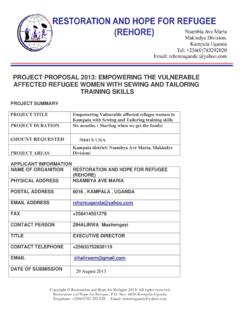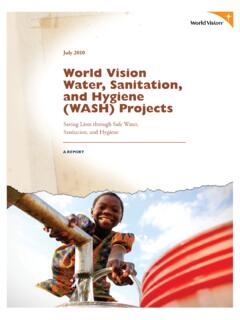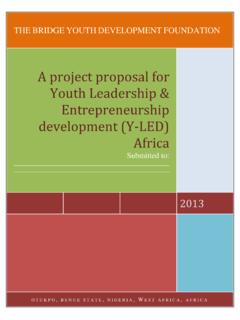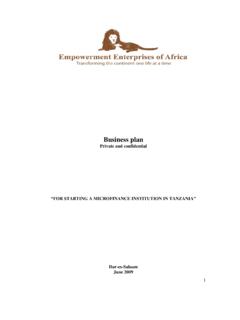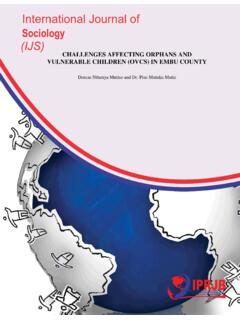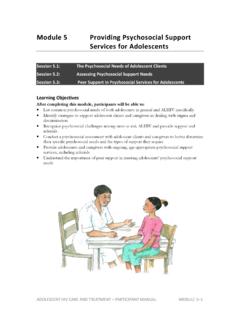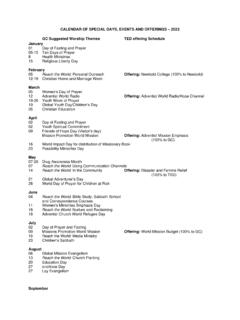Transcription of PROJECT GRANT PROPOSAL FOR FRIENDS REHAB AND …
1 PROJECT GRANT PROPOSAL . FOR. FRIENDS REHAB AND. INSTITUTE OF TECHNICAL. EDUCATION (FRITE). PROJECT LOCATION: Kisumu County, KENYA. PROJECT IMPLEMENTER: Support Aid Ministry 921 Hull Street, Richmond VA, 23224. Website: EXECUTIVE SUMMARY. Support Aid Ministry (SAM), encouraged by its own successful activities and essential service rendered to the neglected and vulnerable children, asked the Kisumu County Government -Kenya for help in providing land for a Rehabilitation and a Vocational Training Centre. The Kisumu County Government was favorably inclined as they considered SAM fully deserving of the required help and granted 2 acres of land along the Kisumu- Ahero highway in Kisumu County. Support Aid Ministry (SAM), intends to set up a facility on the land to be referred to as FRIENDS REHAB and Institute of Technical Education (FRITE).
2 FRITE is bringing out various interconnected projects on this land to support drug addicts, street children and other vulnerable populations, mainly the poor. The Vocational Training Centre will be the key PROJECT with its own building, infrastructure, equipment, staff and maintenance. Construction of buildings on the land will be in four phases based on availability of funds and resources. CONTENTS. BACKGROUND/ RATIONALE -5- Situational Analysis: Kenya .. - 6 - Situational Analysis: Kisumu County .. - 7 - Vision .. - 8 - Mission Statement .. - 9 - PROJECT Abstract .. - 8- About Support Aid Ministry .. -8 - Purpose .. - 8- Target Population .. - 8- PROPOSED ACTIVITIES .. 9 . Expected outcome .. -9 . ORGANIZATION AND MANAGEMENT .. 10 . PROJECT SUSTAINABILITY PLAN .. 10 . PROJECT MONITORING PLAN.
3 10 . Potential Sponsor/ Stakeholders .. 10 - OBJECTIVES ..- 15 - JUSTIFICATION .. - 16 - STRATEGY .. - 16 - Infrastructure Development .. - 16 - Program Development .. - 17 - Financial Sustainability .. - 18 - Creation/Development of the Sub-components: .. - 18 - PROPOSED ACTIVITIES AND BUDGET .. 15 . SUGGESTED ROLES OF THE INITIAL KEY PARTNERS .. -15- PROPOSED ACTIVITY, BUDGET AND TIMELINE .. 15. CONCLUSION . - 16 - BACKGROUND/ RATIONALE. The Kenyan urban poor have very limited opportunities to gain useful skills which would enable them to have access to the labour market and provide for themselves. Even with the Free Primary Education program, a study by the Ministry of Education and the African Population and Health Research Center reports that almost half of the children living in urban slums do not have access to free primary education.
4 Another survey conducted on behalf of Street Family Rehabilitation Trust Fund (2015) paints a grimmer picture for street families. The survey indicates that all street children interviewed across the major towns in Kenya do not have access to any form of education. Sadly, it is very difficult for the majority of urban poor including street families to engage in meaningful trade and self- employment, and very few are able to do so due to a lack of assistance with skills training. Consequently the majority are trapped in the cycle of poverty, often seen begging in the streets with some women even forced to resort to prostitution and survival sex in order to be able to provide for their dependents. The FRIENDS Rehabilitation and Institute of Technical Education is a PROJECT of Support Aid Ministries, a charitable organization that has been working with orphans and vulnerable children in Kenya.
5 Currently, there are 225 children being supported by Support Aid Ministry in Kenya. The FRIENDS Rehabilitation and Institute of Technical Education (FRITE) is an offshoot PROJECT intended to contribute in reducing poverty and enhancing human resource development by providing access to basic, non-formal and vocational skills education to the poor and vulnerable people in Kisumu. The center will also provide rehabilitation services. FRITE will be the largest PROJECT run by Support Aid Ministry and the facility, located in Kisumu County, will serve as the headquarters of Support Aid Ministries. The proposed PROJECT is in line with both Kisumu County and the Kenya Government's poverty reduction strategy. It recognizes education as the vital transformational tool and a formidable instrument for socioeconomic empowerment.
6 It also seeks to create jobs through empowerment of the citizens to acquire skills, entrepreneurship and knowledge. In Kisumu, there are various skills training schemes, but these focuses on limited subjects such as electronics, carpentry, hairdressing, tailoring and computer training. These skills, while certainly beneficial, are not sufficient and only benefit 80 to 120 street and other poor people per year. FRIENDS Rehabilitation and Technical Education Center will provide other programs in addition to what the existing training schemes in Kisumu are providing. Moreover, given the rampant drug problem in Kisumu County, we propose a drug rehabilitation and a recreational center to be built to ensure that a multi-pronged approach is adopted to cope with drug abuse and social problems created by the alarming increase in use of drugs mostly among young people.
7 The center will combine community-based approaches with cost-effective clinical methods. It will also implement a humanitarian and eclectic strategy, including the provision of livelihood opportunities and the use of culture and the arts to deal with drug abuse which threatens social stability in many local communities. A fitness center and mental health facility is envisioned to be part of the proposed institution. Situational Analysis: Kenya Kenyan education is based on an 8-4-4 system: eight years in primary school, four years in secondary and four in tertiary education. The majority of poor Kenyans do not get beyond primary school. The National Curriculum has been in place for some time and is heavily influenced by the British system. The first national exam is the Kenya Certificate of Primary Education (KCPE), which is taken at the end of Standard 8, the last year of primary school.
8 This is an extremely important exam, since the marks gained determine the type of school which a pupil can go on to. Secondary education is extremely expensive and only the better off can afford to move into Form 1. As in primary education the standard of schools varies enormously, from the well-funded and equipped national and provincial schools to the desperately underequipped and under-staffed harambee (self-help spirit). schools. The current graduates from the primary level of education have averaged more than 600,000 every year in recent times. Out of these only 55 percent or 350,000. primary school leavers proceed to secondary schools. The rest (about 300,000) either join the youth polytechnics or the informal sector, with the majority left without opportunities for further education advancement.
9 At the end of the secondary education cycle, about 20,000 join universities while the rest estimated at 200,000 are catered for by the middle level colleges. The existing capacity and capability in the middle level colleges (both private and public) and youth polytechnics are inadequate to absorb the remaining KCPE. and KCSE graduates estimated at 300,000 and 200,000 respectively. This is a target group whose skills development will have to be enhanced through a well harmonized, flexible and demand driven Technical and Vocational Education Training (TVET) system in order to ensure that they contribute meaningfully to economic development. The 2007 World Development Report emphasizes that second-chance . schooling programs are crucial for countries like Kenya, given high drop-out rates from primary school and limited primary to secondary school transition rates.
10 Such training can deliver more readily-marketable skills to these youth, and therefore offer an attractive alternative to traditional schooling that could smooth the school-to-work transition for those leaving the traditional schooling track. Situational Analysis: Kisumu County Kisumu County is one of the 47 counties in Kenya. It has a child rich population, where 0-14 year olds constitute 44% of the total population. In Kisumu County, 19% of the residents have no formal education (Kenya National Bureau of Statistics, 2014). Only 25% of Kisumu County residents have a secondary level of education or above. A total of 57% of Kisumu County residents have a primary level of education only. Two constituencies; Seme and Nyando have the highest share of residents with no formal education at 21% each.

